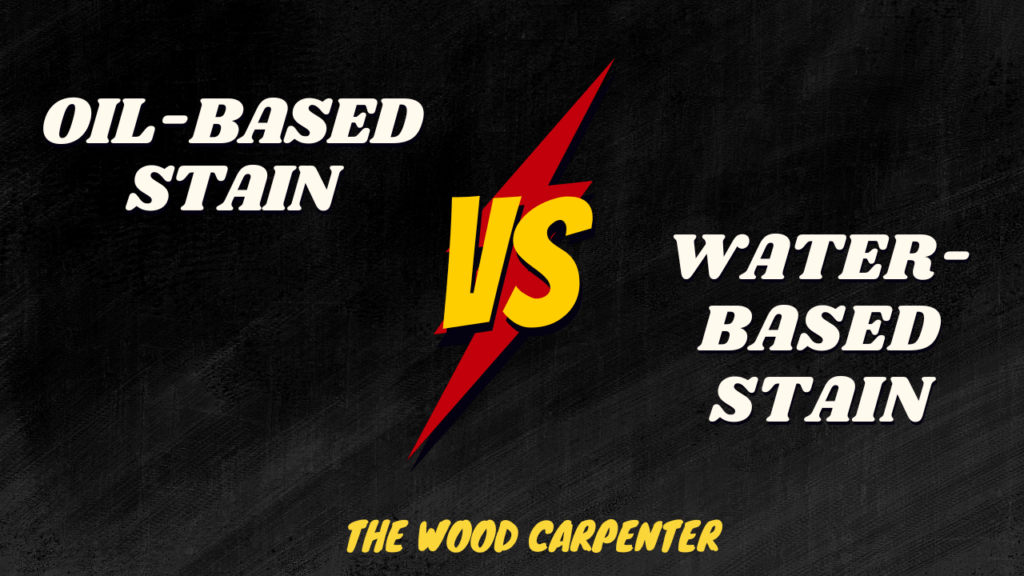
Oil-Based Stain vs Water-Based Stain
When you’re finishing wood, picking the right kind of stain can really change how your project looks, how long it lasts, and how easy it is to take care of. The two most common types are oil-based stains and water-based stains.
Each one has its own strengths and works better for different jobs. So, what’s the difference—and which one should you use? Let’s look at the good and bad sides of each, so you can choose the best one for your project.
What is Oil-Based Stain?
Oil-based stains are made by mixing color (pigment) with oil. This type of stain goes deep into the wood, giving it a rich, dark color that shows off the natural grain. Oil-based stains are a good choice for big surfaces or outdoor wood, where you need a finish that’s strong and long-lasting.
Pros of Oil-Based Stains
Durability: Oil-based stains are more resistant to wear and tear, making them ideal for high-traffic areas.
Rich Color: They provide a deep, vibrant finish that brings out the natural beauty of the wood grain.
Better Penetration: These stains soak into the wood, resulting in longer-lasting color and protection.
Cons of Oil-Based Stains
Long Drying Time: Oil-based stains take much longer to dry than water-based stains, which can delay project completion.
Strong Odor: The solvents used in oil-based stains can produce a strong smell that lingers for hours.
Difficult Cleanup: You’ll need mineral spirits or turpentine to clean brushes and tools, which can be a hassle.
What is Water-Based Stain?
Water-based stains use water as the primary solvent to mix with pigments. This makes them quicker to dry and easier to clean up. Water-based stains are a great choice for indoor projects, providing a clean and even finish without the risk of deep penetration.
Pros of Water-Based Stains
Quick Drying: Water-based stains dry much faster, allowing for multiple coats in a short amount of time.
Easy Cleanup: You can clean up with just soap and water, making it a more convenient option.
Low Odor: These stains have a much lighter odor compared to oil-based stains, making them ideal for indoor use.
Eco-Friendly: With fewer volatile organic compounds (VOCs), water-based stains are better for the environment and safer to use indoors.
Cons of Water-Based Stains
Less Durability: While they dry fast, they don’t last as long as oil-based stains, especially in high-traffic areas.
Faster Application: Since water-based stains dry quickly, they can leave streaks or lap marks if not applied carefully.
Weaker Penetration: Water-based stains sit more on the surface of the wood, making them less effective in terms of long-term protection.
Also read:
Tung Oil vs Danish Oil: A Comprehensive Comparison
Osmo Polyx Oil: How to Apply in 10 Simple Steps
Boiled Linseed Oil Explained: Uses, Advantages, and Tips
Key Differences Between Oil-Based and Water-Based Stains
When to Use Oil-Based Stain
For Outdoor Projects
Oil-based stains are great for outdoor wood like decks, fences, and garden furniture. They go deep into the wood and stand up well to rain, sun, and changing weather.
For Busy or High-Traffic Areas
If you’re working on floors, cabinets, or places that get a lot of use, oil-based stains are a smart choice. They’re strong, last longer, and resist scratches and stains better than water-based ones.
When to Use Water-Based Stain
For Indoor Furniture
Water-based stains are best for indoor projects, like furniture and cabinets. They dry fast and have a low smell, so they’re great for using inside your home.
For Fast or Small Projects
If you’re short on time or want to do multiple coats quickly, water-based stains are perfect. They dry quickly, so you can finish the job in just a day or two.
How to Apply Oil-Based Stain
Prepare the Wood: Sand the wood surface to ensure it is smooth and free of dust.
Stir the Stain: Stir the oil-based stain to ensure the pigments are evenly distributed.
Apply the Stain: Use a brush or cloth to apply the stain in the direction of the wood grain.
Let It Sit: Allow the stain to sit for a few minutes, then wipe off any excess with a clean cloth.
Allow to Dry: Let the stain dry completely, usually 6 to 8 hours. Apply additional coats if necessary.
How to Apply Water-Based Stain
Prepare the Wood: Sand the wood surface to remove any imperfections.
Stir the Stain: Stir the water-based stain to evenly mix the pigments.
Apply the Stain: Use a brush or cloth to apply the stain evenly across the surface.
Wipe Excess: Wipe away any excess stain with a clean rag before it dries.
Allow to Dry: Let the stain dry for about 1 to 2 hours before applying additional coats.
Conclusion: Which One Should You Choose?
When deciding between oil-based and water-based stains, it all comes down to your project needs. If you want deep penetration, rich color, and long-lasting durability, oil-based stains are the better choice. However, if you’re looking for a quicker drying time, easier cleanup, and a more eco-friendly option, water-based stains might be a better fit.
Consider the type of wood, the location of the project, and your timeline before making a decision. Either way, both stains have their place in the world of woodworking, and the right one for you will depend on your unique project needs.
Frequently Asked Questions (FAQs)
1. Can I use oil-based stain on indoor furniture?
Yes, but it’s often better for outdoor or high-traffic areas due to its long drying time and strong odor.
2. How many coats of water-based stain should I apply?
Typically, 2-3 coats of water-based stain are recommended for a rich and even finish.
3. Does oil-based stain smell?
Yes, oil-based stains have a strong odor due to the solvents used, so it’s essential to work in a well-ventilated area.
4. How do I clean up after using water-based stain?
Cleanup for water-based stains is simple with just soap and water.
5. How long should I wait between coats of oil-based stain?
You should wait at least 6 hours between coats of oil-based stain for the best results.

